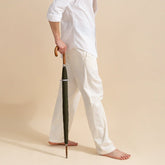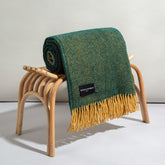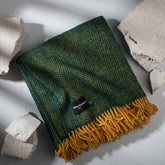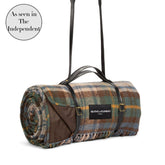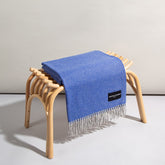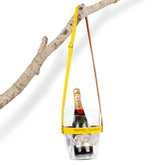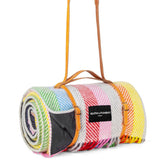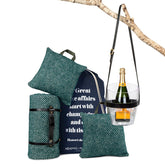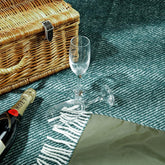Everything You Need to Know About Cashmere Fabric
| Picnic Blankets | Champagne Buckets | Home Throws | Umbrellas | Tote Bags | Candles | Alpaca socks |
Cashmere is a luxurious fabric made from the softest wool of the Cashmere goat. While it's often associated with high prices, you don't have to spend a fortune to enjoy the benefits of this divine fabric. Read everything you should know about the cashmere fabric, from its history and properties to care tips. You'll be eager to add some cashmere pieces to your wardrobe!
What Is Cashmere?
Cashmere is a type of wool that comes from cashmere goats. These goats are originally from the Himalayan region, and they have long, thick fur that protects them from the cold weather. The downy inner layer of their fur is what's used to make cashmere wool.
How Is Cashmere Fabric Made?
Everyone knows that cashmere wool is soft, warm, and luxurious. But have you ever wondered how this exquisite fabric is made? Let's take a closer look at the process of cashmere wool production from start to finish.
Collecting the Wool
The first step in making cashmere is collecting the wool. This is typically done in the spring when the weather is milder, and the goats are shedding their winter coats. Cashmere goats are native to Ladakh, considered a part of the Kashmir region. Still, they can now be found in many other parts of the world, including Mongolia, China, Iran, Afghanistan, and even the United States. The fleece of a cashmere goat is made up of two types of fibers: guard hairs and down fibers.

The guard hairs are the coarse outer hairs that protect the goat from the elements. The down fibers are much softer and more delicate, and these fibers are used to make cashmere wool. The wool is carefully combed out by hand and then sent to a special facility for cleaning and processing.
Cleaning and Processing the Wool
Once the wool arrives at the processing facility, it undergoes a series of cleansing steps, including washing, drying, and combing. These steps remove any dirt, debris, or other impurities from the wool. Afterward, the wool is ready to be spun into yarn.
Spinning the Yarn
The next step in making cashmere is spinning the yarn. This process involves combining several strands of wool to create a single strand of yarn. The yarn is then wound onto a spindle or into a ball to be used to knit or weave fabric.
Knitting or Weaving Fabric
Once the yarn has been spun, it's time to knit or weave it into the fabric. This only can be done by hand; that’s why cashmere fabric is unique. After the fabric has been knitted or woven, it's ready to be dyed and finished.
Dyeing and Finishing Fabric
The final step in making cashmere is dyeing and finishing the fabric. This involves adding colour to the fabric using dyes and applying a series of finishes to protect it from wear and tear. Once this process is complete, the cashmere is ready to be used in clothing, home decor, and more!
How Do You Care for Cashmere?
How to Wash Cashmere
The first thing you need to know about washing cashmere is that you should never put it in the washing machine. The agitator can damage the fibers, and the heat from the dryer can shrink the fabric. Instead, wash your cashmere by hand using cool water and a mild detergent; soak for about 30 minutes.
How to Store Cashmere
When it comes to storing cashmere, there are a few things you should keep in mind. First, never hang your cashmere clothes in the closet. The weight of the fabric will stretch it out and make it lose its shape. Second, always fold your cashmere clothes instead of folding them. This will help prevent creases and wrinkles. Finally, make sure to store your cashmere clothes in a cool, dry place away from direct sunlight.

Caring for Spills and Stains
If you spill on your cashmere sweater, act fast! The best way to deal with the stain will depend on what caused it. For instance, if it's an oil-based stain like makeup or lotion, apply talcum powder or cornstarch to absorb as much of the spill as possible before dabbing gently with a clean cloth soaked in club soda. If the stain persists, take it to a professional dry cleaner. Water-based stains like coffee or red wine can usually be treated at home by blotting with a clean cloth soaked in cool water—just be sure not to rub, which will only further damage the fibers.
Do's And Don’t
Do’s
- Do hand wash or dry clean your cashmere. Machine washing cashmere can break down the fibers and cause shrinkage.
- Do use a mild detergent meant for delicate fabrics. You can find these at most drugstores or online.
- Do shape your garments after washing them. Gently stretch them back into shape and allow them to air dry on a flat surface. Avoid hanging them up to dry, as this can cause stretching and distortion.
- Do store your cashmere in a cool, dry place. Moths love cashmere, so keeping it in an airtight container or bag will protect it from damage.
Don'ts
- Don't use hot water when washing cashmere. This can damage the fibers and cause shrinkage. Stick to cold or lukewarm water instead.
- Don't use regular laundry detergent on cashmere. These harsh chemicals will damage the fibers and lead to fading over time.
- Don't put cashmere in the dryer. The heat will damage the fibers and cause shrinkage. Always air dry your cashmere garments.
- Be sure to hang cashmere up to dry. This will cause stretching and distortion.
Why is Cashmere Expensive
As you can probably guess, the high price tag of cashmere has everything to do with its rarity. Since it takes several goats to produce enough wool for just one sweater and four years for a goat to grow its full coat, there's simply not a lot of cashmere wool in the world. This scarcity drives up the price of cashmere products, making them some of the most expensive clothing items you can buy.
The Cost of Production
One of the reasons why cashmere is so expensive is the cost of production. Unlike other fibers like cotton or wool, cashmere can only be harvested from a specific type of goat known as the Kashmir goat. These goats live in high altitudes in cold climates like Mongolia and China, making harvesting their fiber time-consuming and difficult.
The rarity of the cashmere fiber also contributes to its high cost. A Kashmir goat will only produce around 4 ounces of cashmere fiber in an average year. Compare that to wool, which a sheep can produce in much larger quantities, and it's easy to see why cashmere is such a rare and valuable commodity.
The Quality of the Fabric
Another reason why cashmere is so expensive is the quality of the fabric itself. Cashmere is often referred to as the "diamond of fabrics" because of its strength, softness, and warmth. This makes it perfect for making high-end clothing items like sweaters, cashmere scarves, and gloves.
The delicate nature of cashmere also means it's not as durable as other fabrics like wool or cotton. As a result, cashmere garments need to be treated with great care and can be more expensive to maintain over time.
How is Cashmere better than other wool?
To start with, cashmere is noticeably softer than other types of wool, thanks to the smaller diameter of its fibers. It's also much lighter in weight, making it an excellent choice for garments that need to be warm but not bulky.
And since it's so fine, cashmere can be woven into various fabrics, from delicate silk-cashmere blends to rugged tweeds. The most impressive thing about cashmere is its durability. When properly cared for, a cashmere throw can last for years—even decades—making it a wise financial and environmental investment.
Cashmere has a higher loft than other types of wool, which means it can trap more air and insulate better against cold temperatures. This makes it an ideal fabric for cold-weather garments like sweaters, hats, and scarves.
In contrast, other kinds of wool—such as merino wool—have a lower loft and are better suited for warm-weather garments like shirts and pants. However, some manufacturers use special processing techniques to increase the loft of other wools so that you can also use them for cold-weather garments.
So, the next time you're in the market for a new sweater or piece of outerwear, give cashmere a try!





























